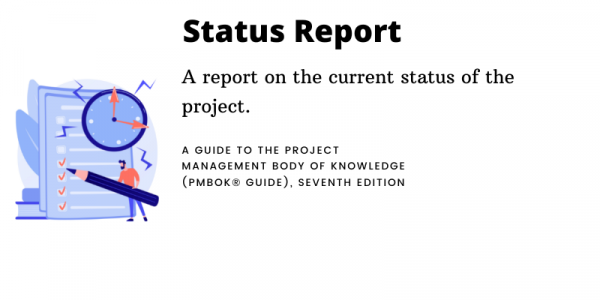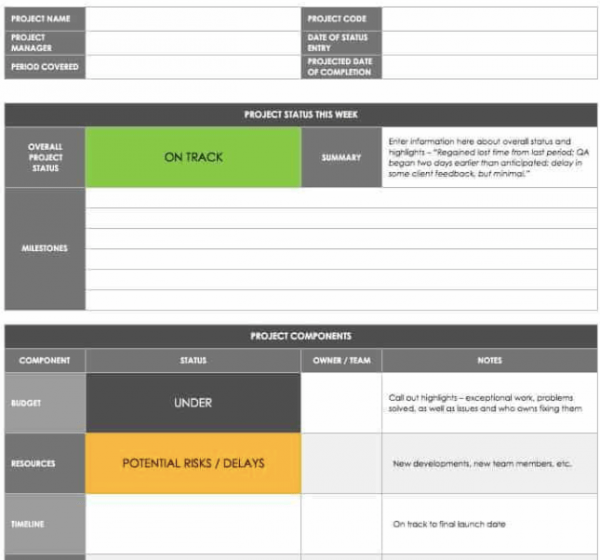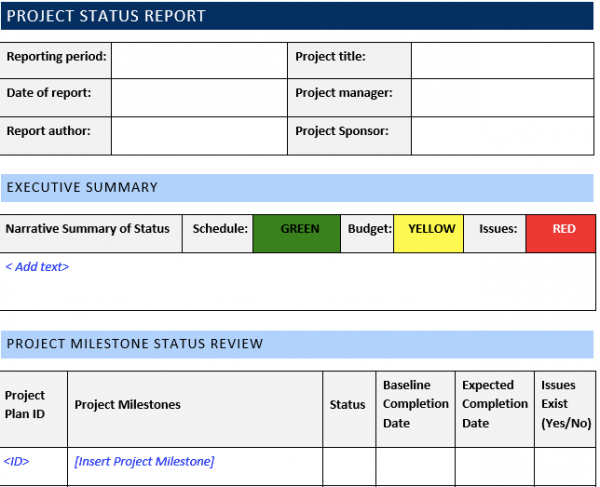A project status report is a document that communicates the current state of a project to its stakeholders. It is typically used to report on progress, risks, and milestones. This report should be brief and to the point. It should be clear, concise, and easy to understand.
The purpose of a project status report is to provide stakeholders with an up-to-date view of the project. It should answer the question: “Where are we at with this project?” The report should also include any risks or issues that may impact the project.
The project status report is a document used to communicate the current status of a project to its stakeholders. This document details the status of a project at a specific point in time. It is used to communicate with project stakeholders about the project’s progress, risks, and issues.
The report is generally updated on a regular basis, such as weekly or monthly, and contains information on the project’s progress, achievements, and challenges. An effective project status report should be clear, concise, and easy to understand. It should also be tailored to the needs of the project’s stakeholders. For example, a project manager might want to include more technical details in the report than a business sponsor.

Importance Of Project Status
Project status reports are important because they help to keep everyone on the same page with regard to the project’s progress. They also help to identify any potential issues or risks that could impact the project’s successful completion.
Project status reports are typically distributed to the project’s sponsors, shareholders, and other key stakeholders. Therefore, it is important that they are well-written and informative. Otherwise, there is a risk that the recipients will lose faith in the project and its management team.
Benefits Of Project Status Report
There are many benefits to using a project status report in project management. Here are a few of the most important ones:
1. It helps managers track the project’s progress.
2. It helps managers identify any potential problems.
3. It makes it easy to communicate the project’s status to stakeholders.
4. It can help improve the project’s overall efficiency.
5. It can help reduce the project’s overall costs.
Providing a clear and concise overview of the project’s current status, allows managers to quickly identify any issues that need to be addressed and makes it easy to track the project’s progress over time.
How Do You Effectively Use A Project Status Report?
There are a few key things to keep in mind when creating and distributing a project status report:
- Be clear and concise: The goal of a project status report is to provide an update on the project’s progress. Therefore, it should be clear and concise. Avoid using jargon or technical language that might not be understood by everyone.
- Tailor the report: As mentioned above, it is important to tailor the content of the report to the needs of the audience. Not everyone needs or wants to see the same level of detail. For example, a business sponsor might only be interested in high-level information while a project manager might need more technical details.
- Distribute regularly: The frequency of distribution will depend on the nature of the project and the needs of the stakeholders. However, it is generally advisable to distribute status reports on a regular basis, such as weekly or monthly. This will help to ensure that everyone has the most up-to-date information on the project’s progress.
- Use visuals: In addition to written content, it can also be helpful to use visuals in your project status report. This could include charts, graphs, or other types of infographics. Visuals can make complex data easier to understand and can help to highlight key points more effectively.
- Get feedback: After distributing your project status report, it is important to get feedback from stakeholders. This will help you to gauge whether or not the report is meeting its intended purpose and whether or not it could be improved in any way.
Contents Of A Project Status Report
At a minimum, your project status report should include information on the following:
- Project name
- Project manager
- Sponsor
- Start date/end date
- Current phase/status (% complete)
- Tasks that have been completed since the last update
- Upcoming tasks
- Risks/issues
- Decisions that have been made
- Next steps
Drafting Your Report: Step-by-Step Guide
Creating a project status report can be done using a spreadsheet program like Microsoft Excel, or a word processing program like Microsoft Word. The report should be created in a way that is easy to understand and interpret, and it should be updated on a regular basis.
But what should you include in your report?
The answer to this question depends on the tasks, phases, and deliverables of your project. However, there are some key elements that every status report should include, such as:
An overview of the project
The project timeline
The deliverables
The current status of the project
Any risks or issues
By including these elements, you can ensure that your status report is both informative and useful for all stakeholders.
Include an overview of the project
The first section of your status report should provide an overview of the project. This overview should include:
– The project name
– The project manager
– The project sponsor
– The project team
– The project objective
By including this information, you can ensure that everyone reading your report is aware of the basic information about the project.
Include the project timeline
Include the project timeline
The project start date
The anticipated completion date
The milestones and deliverables for each phase of the project
By including this information, you can ensure that everyone reading your report is aware of the project schedule and can see how the project is progressing.
Include the deliverables
The third section of your status report should include the deliverables. This section should include:
A list of all deliverables
The status of each deliverable (e.g., complete, in progress, delayed)
The owner of each deliverable
The due date for each deliverable
By including this information, you can ensure that everyone reading your report is aware of what needs to be delivered and when it is due. This section will also help to hold people accountable for their deliverables.
Include the current status of the project
The third section of your status report should include the deliverables. This section should include:
A list of all deliverables
The status of each deliverable (e.g., complete, in progress, delayed)
The owner of each deliverable
The due date for each deliverable
By including this information, you can ensure that everyone reading your report is aware of what needs to be delivered and when it is due. This section will also help to hold people accountable for their deliverables.
Include any risks or issues
The fifth and final section of your status report should include any risks or issues that have arisen since the last report. This section should include:
A list of all risks or issues
The status of each risk or issue (e.g., resolved, in progress, new)
The owner of each risk or issue
The due date for each risk or issue (if applicable)
By including this information, you can ensure that everyone reading your report is aware of any risks or issues that have arisen and can see how they are being managed.
Examples of Project Status Report
Considering a project status report includes information on the achievements of the project team to date and any decisions that need to be made…here are five GENERIC examples of project status reports that can be used to mimic in project management:
- The Executive Summary
The executive summary is a high-level overview of the project. It should include the project’s key objectives, current status, and next steps. This is a good report for upper management or for people who are not intimately familiar with the project.
- The Progress Report
The progress report is a more detailed look at the project’s progress to date. It should include information on what’s been accomplished, what’s left to do, and any risks or issues that have been identified. This report is good for project team members and other stakeholders who want to stay up-to-date on the project’s day-to-day operations.
- The Risks and Issues Report
The risks and issues report is focused on, you guessed it, risks and issues. It should identify all of the potential risks and issues associated with the project, as well as any mitigation plans that have been put in place. This report is important for all stakeholders, as it helps them understand what could go wrong and what is being done to prevent any problems.
- The Financial Report
The financial report provides information on the project’s budget, expenditures to date, and forecasted costs. This report is critical for upper management and other stakeholders who need to track the project’s financial health.
- The Communications Report
The communications report provides information on who needs to be updated on the project, what information needs to be shared, and how often updates should be provided. This report is important for ensuring that everyone involved in the project is on the same page and that important information isn’t falling through the cracks.
How Often Should You Update Your Project Status Report
The frequency of updates will depend on the nature of the project and the needs of stakeholders. However, it is generally advisable to update your project status report on a regular basis, such as weekly or monthly.
This will help ensure that everyone has the most up-to-date information on the project’s progress.
It is also important to update your project status report if there are any significant changes or developments with regard to the project. For example, if there is a change in scope or schedule, this should be reflected in the report.
FAQs
What is a Project Status Report?
A project status report is a valuable tool for project managers and stakeholders. It helps to keep everyone on the same page and ensure that the project is on track.
Why is a Project Status Report essential for a Project Manager?
Project status reports are essential for keeping everyone involved in a project up-to-date on its progress. They also help project managers identify potential risks and issues so that they can be addressed quickly. If you’re working on a project, you should be sure to create a project status report on a regular basis
What are the main benefits of using a project status report?
There are many benefits to using a project status report in project management. It Helps to track the progress of the project, it identifies any potential issues, provides up-to-date information on the project, keeps stakeholders informed and engaged and helps to identify any scope requirement.





